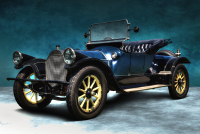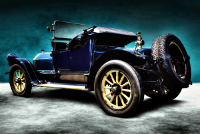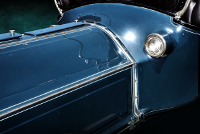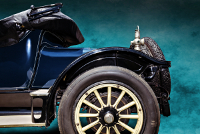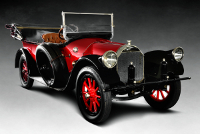Location:
Elegance at Hershey, 2017
Owner: Mark J. Smith | Melvin Village, New Hampshire
Prologue:
1914 is a momentous year for Pierce-Arrow, and an opportune time to discuss a few key elements that made the Pierce-Arrow remarkable. First we revisit the cast-aluminum body, which the firm developed as early as 1905. Second, we comment on the advent of fender-mount headlamps. In true Pierce-Arrow fashion, the headlamp configuration is entirely practical, not stylistic, though credit does fall to Herbert M. Dawley, the marque's artistic lead. Development lasted a few years before formal introduction as an option in 1914, coinciding with a beneficial change to electric lamps. The vast majority of purchasers chose to exercise this option, continuing to do so into the 1930s, when the marque's primary brand identifier finally became standard. Such was the level of conservatism that defined Pierce-Arrow. Even the brand's most recognizable feature is merely an option, only because a drum headlight is the precedent.
- - - - - - - - - -
► Image Source: Nikon D750 (24.3 MP)
References:
- Ralston, Marc. "Pierce-Arrow" A.S. Barnes & Co., Inc., San Diego, CA. 1980, page 85-86, 231
- Ralston, Marc. "Pierce-Arrow, The Golden Age" Jostens Publications, Clarksville, TE. 1984, page 70
- Automobile Quarterly's World of Cars, Kutztown Publishing Co., Kutztown, PA, 1971, pages 211; adapted from "Pierce-Arrow: An American Aristocrat" by Maurice D. Hendry, Volume VI, Number 3
- Troxel's Auto Literature: Sellers of automotive books, historic service manuals, and promotional literature, Troxel's stocked the 1913-1914 Pierce-Arrow Model 38-C2 sales brochure from which the quotes in this feature were taken.
- Hemmings: "Luscious Lamps" by Matt Litwin, May 2, 2016
- Wikipedia: Providing information on A. Atwater Kent and Atwater Kent radios.
- Pierce-Arrow Society: The Society's website offers a nice article on the Pierce-Arrow cast aluminum process.
- Gooding & Co: Specifications checked against this 1916 Pierce-Arrow Model 38.
Only one of these Model 38 Runabouts is believed to exist, and this one extant car is largely original and unrestored. Purchased in 1916 by inventor and radio manufacturer A. Atwater Kent of Portland, Oregon, the car remained in his family until it was purchased by the current owner in 1985. The Kent family had only repainted the car back in 1958, doing so in its original color, and Mr. Smith, the new owner of record, replaced the top in 2012.
While the Model 38 was a popular car for Pierce-Arrow, the runabout style was not so popular. Much of its rarity has to do with the expectation that a Pierce-Arrow is a luxury car, first and foremost. Cost would be a strong factor as well. The Runabout body—also known as the Roadster—uses the same chassis as other Pierce-Arrow models, and costs just as much as either the four or five-passenger touring car. The cost is $4,300 dollars, well over $100,000 today. To purchase a two-seat car for such a high price would be a rare feat.
Pierce-Arrow Cast Aluminum Body Technology
A Pierce-Arrow car of this era is remarkable for its cast aluminum body—that would be a body that is made not of hammered aluminum sheet, but of cast sections cold-riveted together. The structural integrity of this plan was unrivaled in its day, and Pierce-Arrow were certainly the only company to ever succeed on an industrial scale in this largely experimental process. Having recognized that early motor cars were prone to shaking themselves to pieces on primitive roadways, the company conceived of a total platform solution that would result in an incomparably durable car.
Pierce-Arrow said of its body construction: "All Pierce-Arrow bodies are structurally harmonized with the chassis of which they become integral parts. Solidly and honestly built of cast aluminum sections, they are of splendid strength and wonderful lightness. Thoroughly seasoned ash, selected by an expert judge of lumber, is used for reinforcement and for such structural sections as are most appropriately built of wood. Seating arrangements, cushions, upholstery, cape tops, wind shields, and all details are studied and built with the Pierce-Arrow ideal constantly in mind. With the intrinsic soundness of design and construction of Pierce-Arrow bodies comes that sturdiness which speaks for safety in case of accident, and that comfort which makes it possible for the passengers riding in one of these bodies to feel that 'the earth is covered with macadam.' Dependent upon and growing out from these two basic qualities of safety and comfort are those aesthetic sources of pleasure to the owner known as beauty and individuality." And to this last point, it's rather the method of its construction that makes an antique Pierce-Arrow so beautiful.
Atwater Kent Radio History
Atwater Kent built radios in Philadelphia; these ranged from utilitarian breadboard kits that could be assembled by enthusiasts, to formidable luxury items that achieved a furniture-like quality. Or, in the case of the late 1920's Atwater Kent Kiel Golden Voice Radio Table, radio and furniture were united, not unlike the present-day concept of a docking station or device port. Though well known for radios, Kent previously built and sold electro-mechanical parts and domestic wares. Notably, the Kent Electric Manufacturing Company patented the modern ignition coil, providing a ubiquitous part of the 20th century automobile industry.
Motor: 6,795 cc (414 cubic inch) straight 6-cylinder | 101.6 mm x 139.7 mm (4" x 5½")
Valvetrain: T-head, dual-valve, dual ignition
Aspiration: single updraft carburetor
Power: 38 rated horsepower @ 1,800 rpm
Drivetrain: 4-speed manual transmission, rear-wheel drive
Front Suspension: drop-forged I-beam axle, special heat-treated steel, with semi-elliptic leaf springs
Rear Suspension: live axle with semi-elliptic leaf springs
Architecture: steel channel-section frame, cast aluminum body
Wheelbase: 3,238.5 mm (127.5 inches)
Etymology:
The Model 38 takes its designation from the rated horsepower (not actual) of its 6-cylinder motor. The '-2' designation identifies the car as part of what Pierce-Arrow determined to be Series 2 production. The change to series nomenclature began in 1913 with the Model 38-C (which replaced the 36-UU), the Model 48-B (which replaced the 48-SS), and the Model 66-A (which replaced the 66-QQ). The new C-B-A lettering is superficial in that letters ascend from the least powerful, least expensive cars to the most powerful, most expensive cars. None of the 1913 Series 1 cars uses a '-1' to indicate the series. That convention begins here in 1914 with Series 2. So, a 1913 Model 38-C is just that, whereas the 1914 Model 38-C-2 refers to the second version of that Model 38 series.
In this case, we see that the model numbers and letters will remain constant for a few years, whereas the '-#' will identify the production year; this does not necessarily translate to calendar year, as the production cycle changed over in the autumn. Series 1 spanned 1912 to 1913, and Series 2 from 1913 to 1914.
This particular car is a runabout body style, one of seven styles available between 1913 and 1914 on the Model 38 Series 2 platform. We've also specified that the car is unrestored, having received fresh paint in its original color during the 1950s, and a new top a few years prior to writing.
Figures:
Series 2 Model 38 production cracked about 503 units in 1914.
Value:
The Model 38-C-2 Runabout sold new for $4,300 during the 1913 and 1914 model years.
Conservative Originality: Pierce-Arrow's Stalwart Hip-to-Be-Square Approach
The reputation Pierce-Arrow developed at this stage in automotive history, when the car gained momentum against a still-skeptical public, became synonymous with conservatism. The company served a wealthy clientele who were perhaps allied with the skeptics to the extent that durability and operability were paramount. That being the case, it's interesting to note how the company courted this reputation in its literature: "Conservative originality, evolution—not revolution—have been the watchwords of Pierce-Arrow body designers from the first conception—borrowed from the coach builders—to the latest and most distinctive examples of luxurious and comfortable individuality."
So this concept, conservative originality, shows that Pierce-Arrow built itself on a concept that was contradictory to the progress required for longevity in a burgeoning industry. Likely, if the automobile had peaked in the roaring 20s, then Pierce-Arrow would have retained its position at the top of the American market. But time does not stand still, and when it finally came time for revolution at Pierce-Arrow, Pierce-Arrow customers could not accept the offering.
Those Headlamps: Herbert M. Dawley and the Integrated Pierce-Arrow Light
Most sources will explain that the splayed headlamp arrangement is a patented Pierce-Arrow feature. Based on the suggestion of Herbert M. Dawley, the built-in lamps would endure for the remainder of the company's existence. But the larger question is why this design change came to be in the first place. Like the decision to pursue cast aluminum bodies, the headlamp design is built on sound technical thinking: "After much study and experiment we have in these new models adopted a new location for the electric head lamps. These are now placed on the front mud guards in such a manner as to give a much wider diffusion of light, particularly on short curves, a greater illuminated distance, on account of increased height from the road, and a marked improvement over the tendency to distort and exaggerate road inequalities when the lamps are close to the road. A pronounced gain from the mechanical point of view, due to the new location of the head lamps, is the added efficiency of the radiator, which is now directly exposed to the free rush of air."
So we see that this splayed light arrangement—which became the aesthetic calling card of the Pierce-Arrow brand—is entirely logical in the marque's typical approach to design. What's more, the very concept of motoring after dark is relatively new. Lamps first served to identify the automobile in low-light environment, and the technology to cast beams from a moving platform developed gradually. The 1914 Pierce-Arrow headlamp is one important step.
Cast Aluminum: 1914 Updates to the Pierce-Arrow Cast Body
Another timely update for 1914, the driving lights are integrated within the bulkhead. Pierce-Arrow called these 'dash lights,' which first became integrated within the body in the 1914 Series 2. While it can't be said that Pierce-Arrow were interested in art for art's sake—and in fact they repeatedly stated their distaste for design trends—they nevertheless created smoothly integrated forms by virtue of casting these details into the aluminum shell. Because they used common castings in different configurations, most Pierce-Arrow cars from this era are consistent in their detail, stance, and overall level of finish. These dash lights appear on virtually every example.
The Factory Behind the Car: Pierce-Arrow's In-House Manufacture
To say nothing of the car's appearance, Pierce-Arrow were proud of the attention paid to the design and build quality of hardware and electrical components. Their term for this level of dedication was "The Factory Behind the Car," meaning Pierce-Arrow would rather design and build components themselves than use off-the-shelf parts. In some cases, Pierce-Arrow designed parts for manufacture by specialists, as in the Model 38's new Pierce-Arrow-designed starter, which was built by Westinghouse. This was a company that believed they had gotten the car right, and though far from being wrong, felt that it would be a betrayal of brand identity to ever change.
Last Updated: Mar 26, 2025

